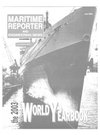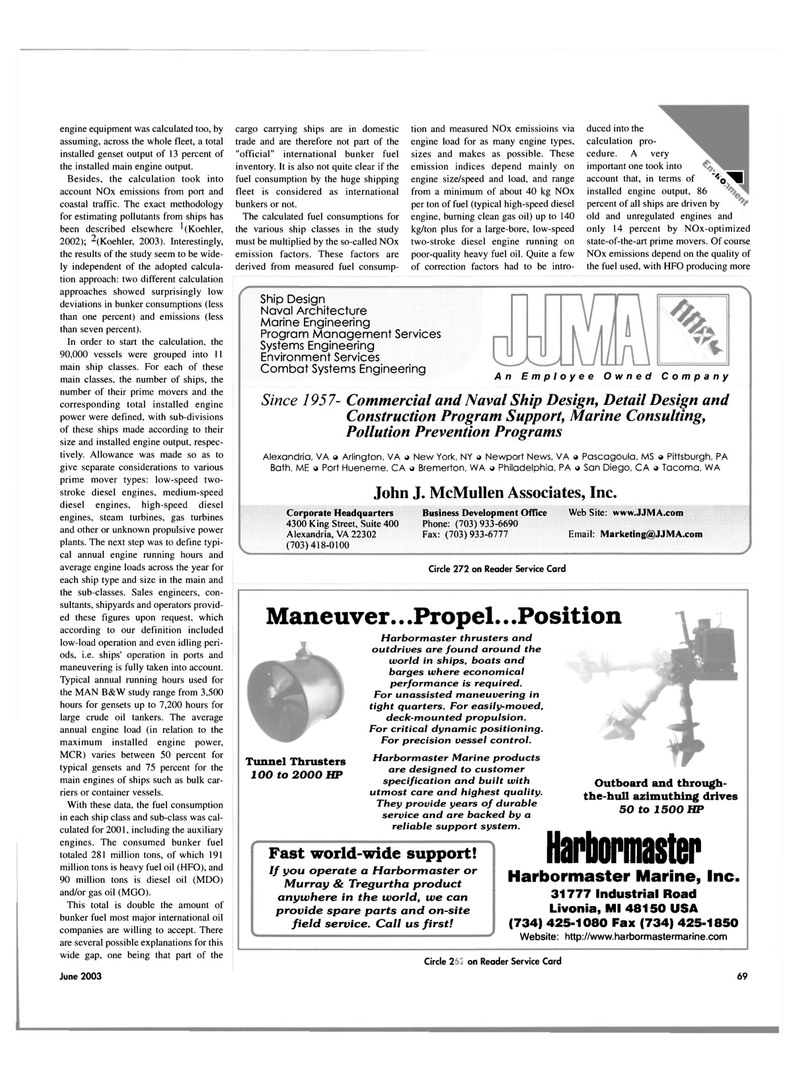
Page 69: of Maritime Reporter Magazine (June 2003)
Read this page in Pdf, Flash or Html5 edition of June 2003 Maritime Reporter Magazine
engine equipment was calculated too, by assuming, across the whole fleet, a total installed genset output of 13 percent of the installed main engine output.
Besides, the calculation took into account NOx emissions from port and coastal traffic. The exact methodology for estimating pollutants from ships has been described elsewhere '(Koehler, 2002); 2(Koehler, 2003). Interestingly, the results of the study seem to be wide- ly independent of the adopted calcula- tion approach: two different calculation approaches showed surprisingly low deviations in bunker consumptions (less than one percent) and emissions (less than seven percent).
In order to start the calculation, the 90,000 vessels were grouped into 11 main ship classes. For each of these main classes, the number of ships, the number of their prime movers and the corresponding total installed engine power were defined, with sub-divisions of these ships made according to their size and installed engine output, respec- tively. Allowance was made so as to give separate considerations to various prime mover types: low-speed two- stroke diesel engines, medium-speed diesel engines, high-speed diesel engines, steam turbines, gas turbines and other or unknown propulsive power plants. The next step was to define typi- cal annual engine running hours and average engine loads across the year for each ship type and size in the main and the sub-classes. Sales engineers, con- sultants, shipyards and operators provid- ed these figures upon request, which according to our definition included low-load operation and even idling peri- ods, i.e. ships' operation in ports and maneuvering is fully taken into account.
Typical annual running hours used for the MAN B&W study range from 3,500 hours for gensets up to 7,200 hours for large crude oil tankers. The average annual engine load (in relation to the maximum installed engine power,
MCR) varies between 50 percent for typical gensets and 75 percent for the main engines of ships such as bulk car- riers or container vessels.
With these data, the fuel consumption in each ship class and sub-class was cal- culated for 2001, including the auxiliary engines. The consumed bunker fuel totaled 281 million tons, of which 191 million tons is heavy fuel oil (HFO), and 90 million tons is diesel oil (MDO) and/or gas oil (MGO).
This total is double the amount of bunker fuel most major international oil companies are willing to accept. There are several possible explanations for this wide gap, one being that part of the cargo carrying ships are in domestic trade and are therefore not part of the "official" international bunker fuel inventory. It is also not quite clear if the fuel consumption by the huge shipping fleet is considered as international bunkers or not.
The calculated fuel consumptions for the various ship classes in the study must be multiplied by the so-called NOx emission factors. These factors are derived from measured fuel consump- tion and measured NOx emissioins via engine load for as many engine types, sizes and makes as possible. These emission indices depend mainly on engine size/speed and load, and range from a minimum of about 40 kg NOx per ton of fuel (typical high-speed diesel engine, burning clean gas oil) up to 140 kg/ton plus for a large-bore, low-speed two-stroke diesel engine running on poor-quality heavy fuel oil. Quite a few of correction factors had to be intro- duced into the calculation pro- cedure. A very important one took into account that, in terms of ^o^® installed engine output, 86 percent of all ships are driven by old and unregulated engines and only 14 percent by NOx-optimized state-of-the-art prime movers. Of course
NOx emissions depend on the quality of the fuel used, with HFO producing more
Ship Design
Naval Architecture
Marine Engineering
Program Management Services
Systems Engineering
Environment Services
Combat Systems Engineering
An Employee Owned Company
Since 1957- Commercial and Naval Ship Design, Detail Design and
Construction Program Support, Marine Consulting,
Pollution Prevention Programs
Alexandria, VA o Arlington, VA a New York, NY j Newport News, VA a Pascagoula, MS o Pittsburgh, PA
Bath, ME a Port Huenerne, CA o Bremerton, WA a Philadelphia, PA « San Diego, CA o Tacoma, WA
John J. McMullen Associates, Inc.
Corporate Headquarters 4300 King Street, Suite 400
Alexandria, VA 22302 (703)418-0100
Business Development Office
Phone: (703)933-6690
Fax: (703)933-6777
Web Site: www.JJMA.com
Email: [email protected]
Circle 272 on Reader Service Card
Maneuver.. .Propel.. .Position
Tunnel Thrusters 100 to 2000 HP
Harbormaster thrusters and outdrives are found around the world in ships, boats and barges where economical performance is required.
For unassisted maneuvering in tight quarters. For easily-moved, deck-mounted propulsion.
For critical dynamic positioning.
For precision vessel control.
Harbormaster Marine products are designed to customer specification and built with utmost care and highest quality.
They provide years of durable service and are backed by a reliable support system.
Fast world-wide support!
If you operate a Harbormaster or
Murray & Tregurtha product anywhere in the world, we can provide spare parts and on-site field service. Call us first!
Outboard and through- the-hull azimuthing drives 50 to 1500 HP
Harbormaster
Harbormaster Marine, Inc. 31777 Industrial Road
Livonia, Ml 48150 USA (734) 425-1080 Fax (734) 425-1850
Website: http://www.harbormastermarine.com
Circle 278 on Reader Service Card
June 2003 69

 68
68

 70
70
